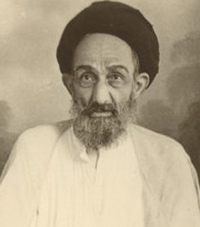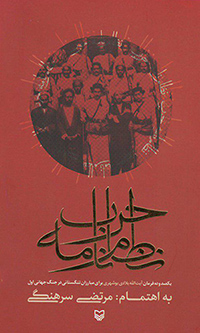“War Regulations” Introduction Conference
Memoirs indicate the end-price of war
Fereshteh Sedaghat Hassan Zadeh
Translated by Ntalie Haghverdian
2017-4-4
On the evening of 9 March 2017, Technical Literature Library of the Central Library of Astan Qods Razavi hosted Morteza Sarhangi, the founder of Defense Literature and Art Department of the Art Division. His introduction and talks about his latest book “War Regulations” was an opportunity to start the first meeting from the series of Shams meetings.
Pile of blank papers horrifies me
Seyyed Alireza Mehrdad, author of the “Holy Defense” and the moderator of the program, at the beginning of the program stated that Mr. Sarahangi supports all the publications made by Soureh Mehr Publication including “Da”, “The leg left behind” and “Norreddin, the son of Iran”. He quoted a popular sentence by Mr. Sarhangi and said: He has a famous saying: “Pile of blank papers horrifies me”; I believe that every author has to institutionalize this sentence. This is due to the fact that, there are many words unsaid and subjects unattended which is terrifying. This very concern leads to an artistic choice and he addresses a historical relic of approximately 100 years old and highlights it.
Proof of Iranians’ Defense Spirit

Morteza Sarhangi talked about his latest book: I travelled to Bushehr in 95 or 96 and there “Lavayeh va Savaneh”[1] book was introduced to me which contained the declarations, speeches and letters of the prominent clergy, “Ayatollah Seyyed Abdallah Beladi Bushehri” published in 500 volumes; the book had never made it outside the county. Five or six pages of the book elaborated on the customs of war designed in 110 articles. In the introduction of the book, Ayatollah Beladi Bushehri, had stated that warriors of the south in Tanestan (I World War) were up against the invasion of the British Army and sent a message to me that they don’t know tactics of war. I immediately took measures, with the spiritual support of Imam Ali, designed the War Regulations in 110 Articles and sent it to them.
Founder of the Department of Defense Literature and Art of the Art Division stated: articles 22 and 23 of this regulation concerning reporting and photography of war were very interesting. Ayatollah Bushehri, almost 100 years ago, commands the warriors to take pictures of the battlefield. How many cameras were there in Iran? How many in Bushehr? How many in Tangestan? It feels like he has designed and drafted this Regulation for all times and it is interesting that all articles concern defense mechanisms and stress the importance of protecting the territory of Iran. It might be that thousand years of the Iranian history is due to their defense spirit.
He added: years back, I spoke of “Lavayeh va Savaneh” in a university. The professors and students later approached me and requested the book. The publication volume was only 500 and I couldn’t refer them to its source so I decided to free it from isolation. I haven’t done anything special about the book but extracted the regulation out of it.
In Shia History, War Tactics Derive from Traditions

In the meeting, Ali Barati Gajvan, author and literary critic, present as a technical expert, stated that some of the articles of “War Regulations” were not applied in the eight years of Holy Defense and stressed: I strongly believe that at the time the book has not been available and similar war tactics observed in the Shia history including the Holy Defense is due to the references made to common historical sources, i.e., hadith and traditions.
He added: the pose of the regulation is commanding and not guidance which indicates the status of Ayatoolah Beladi Bushehri and strong reference of such regulations to the traditions; the prose of the regulation commands the soldiers to waste no time and apply the tactics accordingly.
“I wish” of Morteza Sarhangi
Seyyed Alireza Mehrdad, stated the importance of legitimizing the Holy Defense and said: This important aspect was realized through presence of prominent clergies in the Holy Defense who participated and coded the operations which is also included in some articles of the War Regulations stating that some operations have to be carried on by clergies. He referred to articles 22 and 23 of the War Regulations indicating reporting and photography of the battlefield and questioned its application in the Holy Defense. Sarhangi responded: reporting and memoir recording started in the midst of the war in 85 however photography covered the war since its onset. Photography during the war is for dissemination of information but after that is evidence.
Author of “Secrets of imposed war by Iraqi captives” added: I may not have regretted anything in my life and never said “I wish” since I’ve done everything in my power. However, concerning the Iraqi captives I must say: “I wish”. Iraqi captives in Iran wrote 65 books and left our county. I wish there were 650 books. This is one of my regrets. Imam used to say that they are guests here. We had the Commission of Iraqi Captives’ Administration which would regulate their affairs. Our regulations were more advanced and humane than the Geneva Convention covering more articles. We printed and translated these regulations into English and Arabic. The documents include the book on the escape of Iraqi captives from the camps in Iran, the other document was the regulations and the other book was on prominent captives. We had prominent features that nobody is aware of such as Ismail Hemadi brother of Sadun Hemadi. The lunch provided to the captives was the same given to Iranian soldiers and guards. Their daily portions had better quality than the food provided to us by the newspaper office. I was a journalist at the time and wouldn’t eat lunch; I used to joint them (he laughs). I don’t want to say that they had a good time here. Captivity is hard in any form but we didn’t make it harder.
Concerning reporting, Sarhangi added: Hassan Bagheri is a commander who has left 17 thousand pages based on which so far 8 books have been published.
Media System, Literature of War Persisting
Founder of the Defense Literature and Art Department said that the prose adopted in the books published by the division is different from most books published about the Holy Defense and the martyrs; the martyr in the books published by the division is accessible by the audience to benchmark. He added: there are two types of literature in war. One is the literature during the war which is promotional, epic and sensational which encourages the public to resist and cope with difficulties; this applies all over the world. However, the literature upon the end of the war is rational. Rational & promotional are quite different. Our media is still applying the literature used during the war while our literature has changed.
Sarhangi stated that rare incidents occur during war and emphasized the importance of recording memoirs. He stated that memoirs indicate the end price of war and said: Saddam took pilot Lashgari hostage who had crashed five days prior to formal onset of war in Iraq. He says: I was accommodated in a house by the intelligence service with perfect facilities. One day, the agent in charge came to me and said that Saddam is asking you to talk one minute in the TV and say that Iran has invaded Iraq. Then you will have anything you want anywhere in the world. I said: why do you want to create a traitor of me? I won’t do that.
This one minute turned into 18 years of solitary confinement for Lashgari which shows the end price of war. Due to the promotional prose adopted by the media today, conceals the end price when a bank manager threatens: if you stop my 300 million monthly salary, I will file a complaint with World Bank, no one asks “why”? Pilot Lashgari dedicated 18 years of his life against one minute. We, now, have no idea what is the end price of what we do with the blessings and endowments of our country. We don’t feel responsible to turn extra lights off. Memoirs are trying to determine the end price of our behavior towards our country.
Women in Holy Defense; Different Complexion
He perceived the present ear as the golden era of Holy Defense Literature and stated: Our soldiers are now alive and ready to talk; authors are active and women have made their way into the literature of war and are changing its complexion from its very foundation. Holy Defense is now in our homes and lives.
Sarhangi noted that a memoir of Pilot Lashgari’s spouse, written by Golestan Jafarian and published by Soureh Mehr Publication, is out in the market and said: Memoirs of this woman “Days of no Mirror” will be published soon. This book represents a full life where you don’t hear the bullets by witness war operations.
The first meeting of the Shams Series was dedicated to introduction of “War Regulations” by Morteza Sarhangi supported by the Organization of Libraries, Museums Administration and Document Center of Astan Qods Razavi which will be pursued on a monthly basis attended by prominent authors to offer a scientific and sincere ambiance for communication of authors and audience in one of the largest and richest libraries in the regions.
This organizations hold 7 thousand and 239 study references on Iran and Iraq war of which 1205 are memoirs, 930 are stories, 3 thousand and 498 are about martyrs, 124 defines reasons of war, 63 are dramas, 44 are about Khoramshahr, 39 are pictures, 17 are about damages and 12 are promotional. There are other books including the reports of veterans, speeches, poems, wills, economic and religious aspects, life stories, etc.
Number of Visits: 4402








The latest
Memoirs of Hujjat al-Islam Reza Motalebi
Hujjat al-Islam Reza Motalebi is a cleric from Isfahan. Before the revolution, he was the imam of the Fallah Mosque – which was later renamed Abuzar Mosque. By his presence and efforts, Abuzar Mosque soon became a base for supporters of the Imam and the revolution. After the victory of the revolution, he played a role in uniting forces and maintaining political vitality in southwest Tehran.The Necessity of Receiving Feedback in Oral History
Whenever we engage in a task, we naturally seek ways to evaluate our performance — to correct shortcomings and enhance strengths. Such refinement is only possible through the feedback we receive from others. Consider, for instance, a basketball player whose shots are consistently accurate; should he begin shooting blindfolded, his success rate would rapidly decline, as he would be deprived of essential feedback from each attempt.Sir Saeed
The book “Sir Saeed” is a documentary [narrative] of the life of martyr Seyyed Mohammad Saeed Jafari, written by Mohammad Mehdi Hemmati and published by Rahiyar Publications. In March 2024, this book was recognized as one of the selected documentary biographies in the 21st edition of the Sacred Defense Book of the Year Award. The following text is a review on the mentioned book.Morteza Tavakoli Narrates Student Activities
I am from Isfahan, born in 1336 (1957). I entered Mashhad University with a bag of fiery feelings and a desire for rights and freedom. Less than three months into the academic year, I was arrested in Azar 1355 (November 1976), or perhaps in 1354 (1975). I was detained for about 35 days. The reason for my arrest was that we gathered like-minded students in the Faculty of Literature on 16th of Azar ...

